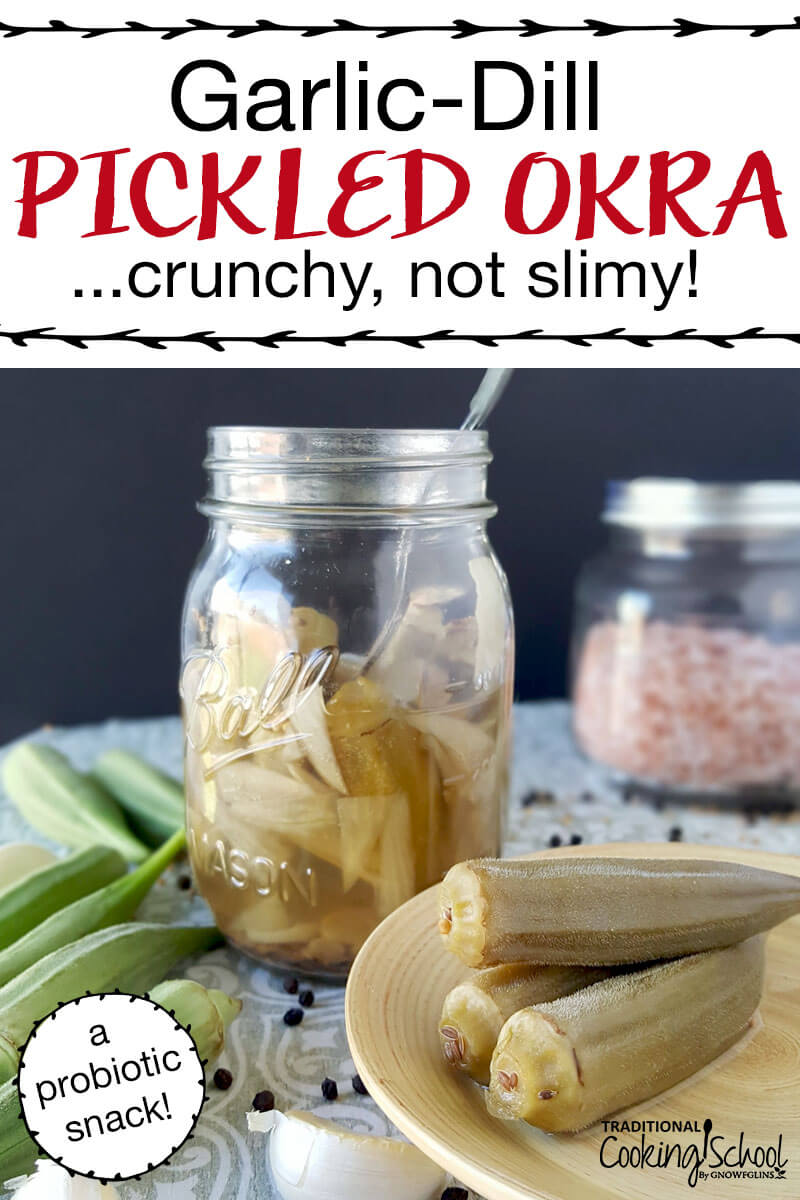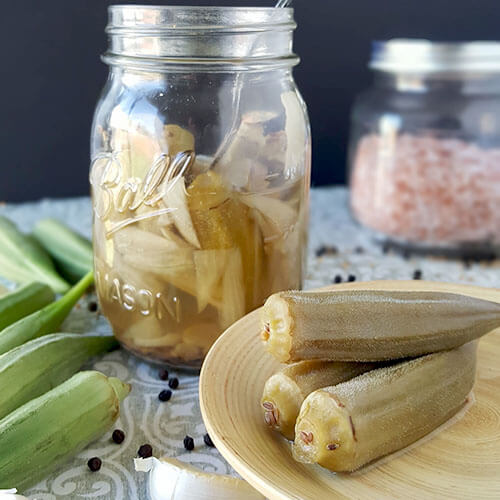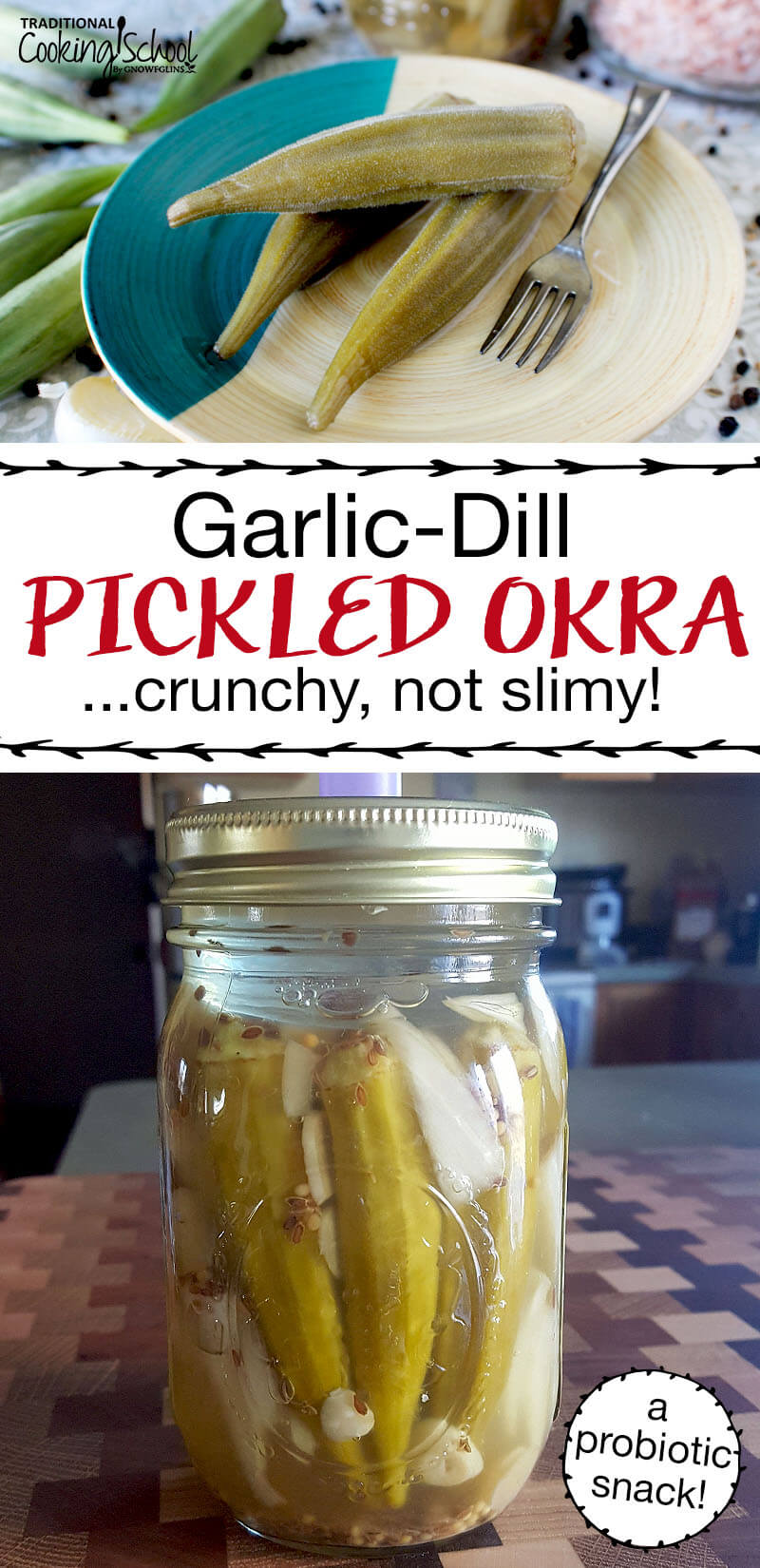 Once you discover how easy, healthy, and delicious lacto-fermentation is, you want to ferment all the things, right?
Once you discover how easy, healthy, and delicious lacto-fermentation is, you want to ferment all the things, right?
Fermented veggies are so gut-friendly, and the possibilities are almost limitless.
You can even lacto-ferment a veggie you don’t typically enjoy… and by the end, it transforms into a crunchy, probiotic-rich snack you love!
I’m talking lacto-fermented okra, everyone. 😉
Don’t Hate On Okra, It’s Good For You!
Now, some people really love okra and have no problems eating it in various ways. I never liked it as a kid.
In fact, until a few years into following Trim Healthy Mama there was no way I’d touch an okra. Because it’s slimy, folks.
However, when you learn that okra can help keep blood sugar stable, you get a little brave. You try it in smoothies and discover that okra isn’t that bad when disguised by chocolate.
Another day, you get really brave and cook it up in a cast iron skillet with some coconut oil.
Of course, you have to cook the “snot” out of it because the slime factor is just a no-go. But blackened okra is pretty tasty, especially with a spicy piece of salmon!
Turns out, that “slime” some find so off-putting is really good for you. It can help soothe the gut and it’s wonderful for thickening shakes, smoothies, soups, and sauces too. Pureed okra is also a thrifty way to expand dishes like chili and spaghetti sauce. Okra pairs excellently with tomatoes!
Did you know that okra…
- is high in fiber, vitamin C, vitamin K, potassium, and folate (source)
- helps fight fatigue (source)
- helps digestion and elimination (source)
- prevents the adhesion of Helicobacter pylori (which causes ulcers) to the gut lining (source)
- helps lower blood sugar (source and source)
- helps fight depression, thanks to its rich source of flavinoids such as quercitin (source and source)
- may help fight cancer (source)
What’s The Best Way To Eat Okra?
Ideally, okra should be eaten raw or lightly cooked for the best nutritional value. However, in its raw form, it is high in oxalates (read why these can be harmful).
To minimize oxalates, you can cook okra (yet lose some of its nutrition) or… ferment it into crunchy pickles packed with probiotics!
And the slime? It dissipates enough to not be unpleasant at all.
I love this super simple recipe for lacto-fermented okra! It has a delightfully dilly, garlicky, salty-sour taste. The okra pods stay crunchy, even without adding grape leaves.
If you’d like to mix it up a little, feel free to use your favorite pickling seasoning mix instead.
Okra Precautions
Because okra is high in vitamin K1, people on blood thinners should use caution.
Those who have a diverticulitis flare up should avoid okra because of the fiber and seeds.
If you’re diabetic and take Metformin, overconsumption of okra can interfere with that drug’s effectiveness (source).
Okra is sometimes categorized as a nightshade, however, this is not correct. TCS Moderator Cevy K. shares,
“Okra is not a nightshade and is not in the botanical group known as solanaceae. However, it does contain the same highly toxic alkaloid, solanine, which is the chemical found in nightshades that causes inflammatory responses. This is why it is grouped together with nightshades (same as blueberries, huckleberries and artichokes).” (Source.)
Finally, you may be surprised to learn that okra is technically a fruit!
How To Make Lacto-Fermented Okra Pickles
After seeing so many Trim Healthy Mamas raving about store-bought pickled okra, I had to try fermenting my own. I love pickles of all types but especially lacto-fermented pickles for all their healthy benefits.
The hardest part is waiting for them to be done! Depending on the time of year this can be in as little as three days or as many as ten.
After a day or two, bubbles start to form, and a wonderful pickle-y aroma surrounds the jar, making your mouth water every time you walk by it (ask me how I know that 😉 ).
Let your taste decide how long they should ferment! If you check after a few days and think they need more time, let them go a little longer.
Okra pickles are a great way to add crunch and flavor to your meals and snacks.
If you’re a Trim Healthy Mama plan follower, you’ll love this easy and healthy way to get that okra in every day! You’ll probably want to make these by the gallon, actually, so increase the following recipe as needed. 😉
You Will Need…
- 1 pint-sized Mason jar
- fermenting weights
- fermenting lid

Garlic-Dill Pickled Okra (crunchy, not slimy probiotic snack!)
I used to think okra was slimy. That all changed the day I met garlic-dill pickled okra! The newest kid on the lacto-fermentation block, these homemade crispy crunchy okra pickles are every bit as good as sauerkraut or cucumber pickles. Plus, they stabilize blood sugar, fight fatigue, and protect the gut! Make a pint (or a gallon) because you're going to love this easy ferment!
Ingredients
- 1 cup pure water
- 2 teaspoons sea salt
- 1 teaspoon dried dill seed
- 1/2 teaspoon mustard seed
- 1/2 teaspoon whole black peppercorns
- 12 to 16 fresh okra pods washed and tops trimmed
- 2 cloves garlic thinly sliced
- 1/4 cup onion sliced (or chunks)
Instructions
-
Wash okra pods and trim the tops (I don't cut them off completely).
-
Dissolve salt in water and set aside.
-
Add spices to bottom of the jar.
-
Pack okra vertically into Mason jar.
-
Stuff the garlic slices and onion pieces throughout the okra.
-
Pour brine into jar, leaving room for fermenting weights.
-
Place fermenting weights on top of the okra and press down.
-
Affix the fermenting lid.
-
Leave on your counter for 3 to 10 days, or until fermented to suit your taste.
-
Once fermented, remove weights and replace fermenting lid with a regular lid.
-
Refrigerate to let them age a few more days (or weeks) if desired, or enjoy when cold. They stay crunchy for several weeks in the fridge!
Recipe Notes
I ferment my okra pickles on the counter for about 6 or 7 days, then let them slowly continue fermenting in the fridge for another week or two.
Do You Like Okra? Have You Ever Made Garlic-Dill Pickled Okra?
We only recommend products and services we wholeheartedly endorse. This post may contain special links through which we earn a small commission if you make a purchase (though your price is the same).



I grew to love okra as a child growing up, slime and all…and I have made water-bath canned pickled okra, which I absolutely love! It’s too cool and damp where we live to grow my own, so I am stuck maybe getting some from a local farmer’s market, if I am lucky…going to be more intentional about looking for fresh okra and using this method to ferment it!
never seen fresh Okra, but can get frozen, whole pods, any chance they would work?
Great article, can’t wait to lacto ferment some okra, it is growing like a weed right now. Thanks for sharing this! Also, okra is not a nightshade. Okra is a mallow (Malvaceae) closely related to Hibiscus, cotton, roselle, cacoa, et cetera. Nightshades (Solanaceae) commonly grown are tomato, pepper, eggplant, tomatillo, tobacco, potato, ground cherry, et cetera. Cheers
I just tried some pickled okra and absolutely love it. I have 2 potted okra plants and they constantly have fruit. I use them for Filipino as well as stir-fry dishes. I also love fried okra and going to try some with panko. I had never tried pickled okra and what a surprise…good stuff. So ono as we say in Hawaii. Mahalo for the recipe.
I tried fermenting okra for the second time. First batch was delicious. This bath I had to throw away. After a few days fermenting they got extra slimy and the garlic in them turned green. It was gross. Any suggestions what caused this.
Looking forward to making this recipe today. I’m wondering if there is a reason you say they only keep for two weeks?
I was really hoping for a long lasting ferment to feed my family through the winter along with our fermented pickles.
I’d prefer to ferment then can if I can get away with it
I’m from the South and I love Okra slime and all. One way to hide the slime is to cook up okra and tomatoes. It’s a popular dish in the South and not slimy like plain boiled okra.